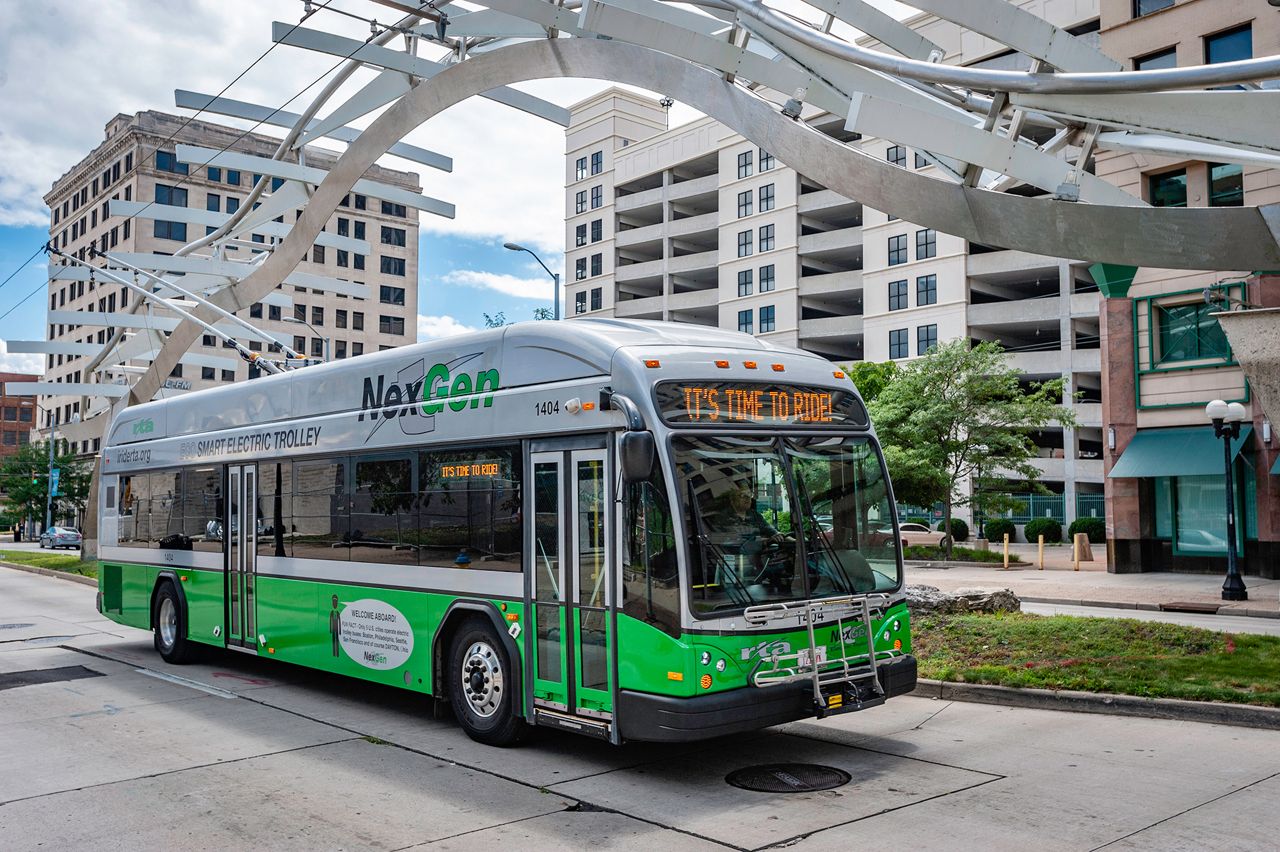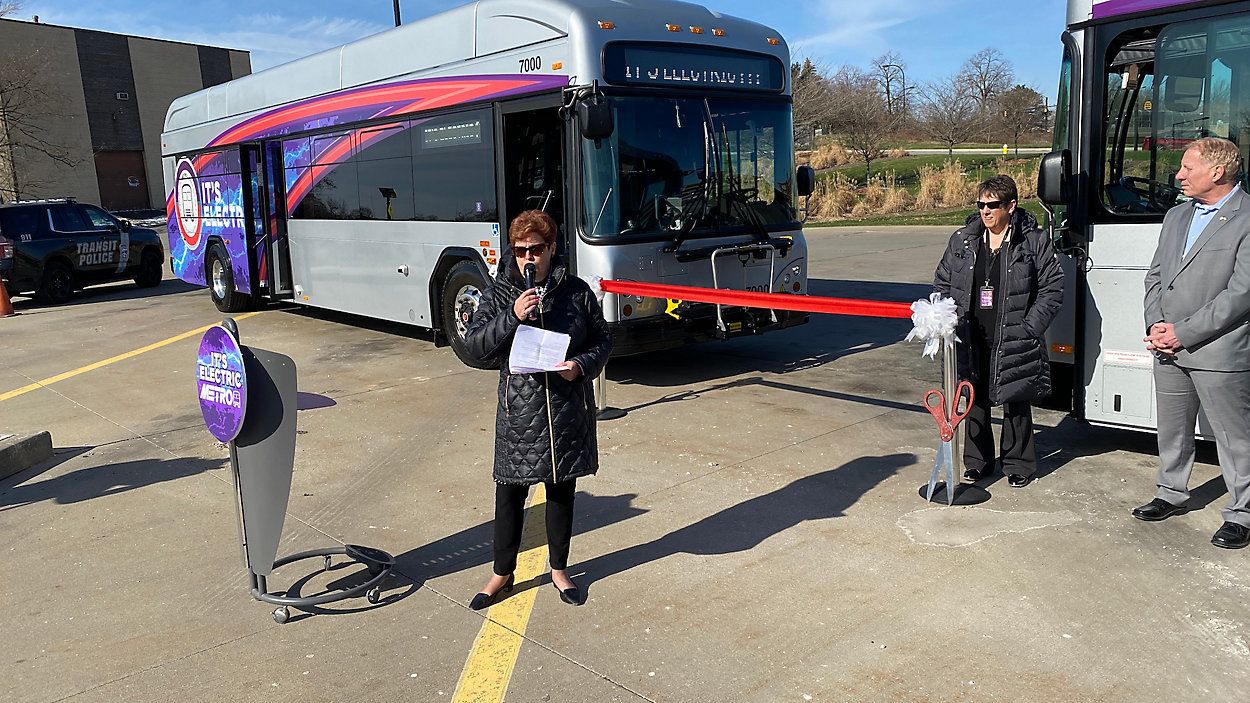CINCINNATI — Hamilton County’s bus operator plans to add up to 11 new electric vehicles (EVs) to its fleet as a growing number of transit agencies and government organizations look for cost effective green solutions to meet their evolving transportation needs.
What You Need To Know
- Metro is looking to put $5.5 million in grant money toward the purchase of up to 11 electric buses
- These would be the first electric buses used for fixed routes in Hamilton County
- Supporters of the project say that while electric buses are more expensive upfront, they're good long-term investments because of savings on fuel and upkeep
- Metro hopes to purchase the buses next year
Metro — the nonprofit, tax-funded public bus service operated by the Southwest Ohio Regional Transit Authority — received $5.5 million in federal grant funding toward the purchase of the buses.
This funding follows additional grants awarded to Metro earlier this year to diversify its energy usage by replacing aging transit vehicles and infrastructure with zero-emission vehicles.
An exact timeline for the purchase and roll out is not yet available. But Metro spokesperson Pat LaFleur said it should happen next year.
“Making transportation more convenient and more sustainable is at the heart of the Reinventing Metro mission, and such initiatives wouldn’t be possible without partnerships like these,” said Darryl Haley, the agency's CEO and general manager.
Reinventing Metro is the transit agency’s plan to modernize its service through new innovations ranging from on-bus Wi-Fi and improved real-time arrival information to updating its fleet with more environmentally friendly coaches.
The new electric buses will be the first used by Metro for fixed-route service. The transit agency is also buying three EVs for its Access paratransit service as well.
Metro currently has 357 buses for fixed-route service, including 27 hybrids.
“We are always exploring and pursuing zero-emissions alternatives to reduce our reliance on diesel,” LaFleur said.
Grant funds ‘electrify’ efforts by transit agencies to go green
Metro received the grant funding through Ohio-Kentucky-Indiana Regional Council of Governments (OKI), which works with communities in eight counties to advocate for federal funding to support local and interstate projects. OKI has ultimate authority over all federal dollars spent on surface transportation in the region.
Robert Koehler, OKI’s deputy executive director, said he’s been encouraged to see “positive momentum for electric buses” across the region.
“The electrification of the region’s bus systems will have many positive impacts, including making our air cleaner, our streets quieter, and improving public health,” he said.

Transit agencies across the United States have explored going electric over the past several years. But the increasing availability of EVs and rising energy costs have made doing so more popular than ever.
Earlier this year, the Antelope Valley Transit Authority in Lancaster, Calif., became the first bus service in the United States to have an all-electric fleet, according to Government Technology magazine. The agency has 57 full-size battery electric buses, along with 20 commuter coaches and 10 micro-transit vans.
The Greater Dayton Regional Transit Authority (RTA) began testing its first NexGen model electric trolley on Southwest Ohio streets back in 2014. The agency considered the $1.4 million vehicle a prototype to determine if purchasing more would be cost effective.
In 2019, RTA bought a “large number of NexGen trolleys” for roughly $1 million each, per the organization’s website. As of 2020, the agency operates 44 electric buses, per the National Transit Database managed by the Federal Transit Administration.
Akron’s Metro RTA purchased its first two electric buses this past March. The price tag for each coach was about $924,000, according to spokesperson Molly Becker. The agency used grants to buy them.
LaFleur couldn’t say exactly how much the Metro buses will cost because the agency is still exploring models and options. But typically speaking, those costs can be as much as twice as much as a bus with a combustion engine.
While electric vehicles might cost more up front than fossil fuel-powered counterparts, they are cheaper to operate and maintain over their lifetime, said Mark Jeffreys, a Cincinnati City Council member and OKI board member.

Jeffreys — a member of the city’s Climate, Environment & Infrastructure committee — noted that data show EVs cost less money to repair and because the price of gas continues to rise.
“The return on investment on this is significant in the medium term. I’m not even talking long term because you end up actually saving more money given saving on maintenance and refueling,” he added.
Metro RTA hasn’t experienced many issues with its electric buses — dubbed “Volt” and “Bolt,” Becker said. She mentioned that a manufacturing issue took the coaches out of service for a short time, but overall, the ride has been “pretty smooth.”
The Northeast Ohio transit agency uses its electric buses “all over the city,” Becker said. She added that the buses get up to 160 miles on a single charge, which is about 10 more miles than expected. Just as importantly, they can be on the road for a full day without needing to charge them.
Metro RTA has plans to purchase a third electric bus soon, Becker said.
In Cincinnati, SORTA hasn’t yet determined the routes Metro’s new electric buses would serve. Before that happens, the agency needs to buy the buses and “assess them,” LaFleur said. Then Metro will need to install accompanying infrastructure such as charging stations and buy parts and repair equipment.
Metro’s EV grant was one of two awards it received from OKI. The second grant of $7.9 million will go toward the renovation of an operations and maintenance facility on Paddock Road in Bond Hill.
The project is still in the early design phase, but the current concept includes enhanced vehicle storage, upgraded maintenance spaces and new employee amenities, LaFleur said. It will also better position Metro for future service improvements and expansion, specifically when it comes to new technologies and fleet upgrades, including zero-emission vehicles, LaFleur said.
Investing in the future of transportation and Ohio communities
Oliver Kroner, the city's director of Environment and Sustainability, called the investment in alternative fuel models a good thing for the future health of the greater Cincinnati region and the country.
The world put 1% more heat-trapping carbon dioxide in the air than last year, which is bad news for the fight against climate change, the Associated Press reported Thursday. About one-third of Cincinnati’s carbon footprint comes from transportation, Kroner said.
As part of its commitment to the Green Cincinnati Plan, the City of Cincinnati announced a goal of having an all-electric fleet by 2035.
“As we map our pathway to carbon neutrality, public transportation, biking, walking, and electric vehicles are all key components,” Kroner said. “This means we are giving strategic thought to long-term EV charging needs, and what this means for infrastructure planning.”
Investing in infrastructure is a key part of the fleet electrification process, according to OKI CEO Mark Policinski. He stressed that the organization plans to invest tens of millions of dollars in public and private EV infrastructure in the next several years.
“Simply put, the future of transportation is electric, and OKI has been preparing for them for years,” he said. “Access to EV charging stations is critical to keeping our region competitive and to attracting and retaining talent, families and businesses.”



